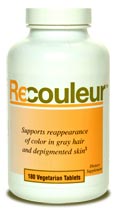Vitiligo Regimen
Summary: Use PABA
internally and externally, a good multivitamin and
multimineral, additional pantothenic acid, Vitol Great Hair
or other high biotin supplement, and replenish the
intestinal flora.

Vitiligo is a condition where areas of skin become depigmented. It appears to be mostly a B-vitamin deficiency, especially those of PABA, pantothenic acid, biotin, folic acid, and possibly B6, but may also be related to some mineral deficiency such as copper or zinc (provided in the multivitamin and/or multimineral).
In this regimen, PABA and pantothenic acid are taken separately, but biotin and folic acid are included in many multivitamins.
Many multivitamins include as little as 8% RDA biotin, so one with 100% RDA or more must be
used, such as many of those recommended in the Multivitamin Section
Life Extension Mix (multivitamin and mineral) can be used
instead of the multivitamin, multimineral, and Great Hair
since it contains a great deal of biotin (3000mcg or 1000%
RDA).
PABA and pantothenic acid are B vitamins widely available in health food stores and are usually quite inexpensive. As well as taking PABA
internally (1000 to 2000mg per day), it should also be used topically.
It is available in powder form from www.lef.org and can be used to make a topical by blending with aloe
juice, emu oil, water, or other carrier or PABA capsules can
be opened to use the powder inside.
A calcium magnesium supplement is also recommended since these minerals are crucial to many body processes as well as assist in absorption and production of some vitamins, like B6. See any of the recommended products in the Multimineral Section.
Since most B vitamins including biotin are manufactured by intestinal flora, a malady caused by a lack of them may indicate a problem with the flora. This can be caused by an improper bacteria balance or even parasites. To repair mild cases of imbalance, a mini program can be used
if supplementation fails to greatly improve the condition. This would be using 1/2 tsp or 1 to 2 capsules turmeric powder and 1/2 tsp or 1 to 2 capsules or more fennel seeds two or three times per day for up to three weeks, using more fennel seeds if the turmeric causes stomach upset. Two hours after each serving of the turmeric and fennel seeds, a wide range beneficial bacteria is used, such as Jarrodophilus or PB8.
Good yogurt (like Horizon or Stonyfield Farms) can be used instead of the bacteria
supplement. Butter is one of the only sources of butyric acid, a valuable component to stimulate B vitamin production, and it is highly recommended to use it (in moderation) at least twice per week.
If after two weeks of this there is not a marked improvement,
use a parasite regimen. Do this while also following at least loosely "Eat Right For Your Type" and the Zone diet, getting adequate protein and (good) fats at each meal or snack while avoiding hydrogenated and trans fats (found in processed and fried foods and margarine) as well as avoiding wheat, potatoes, eggplant, and processed corn products like corn meal and using sugar only as a condiment.
What Causes Vitiligo? by SuperNatural Health, Inc. Folic acid, vitamin B12, vitamin C, copper, and zincby Audrey VanStockum Scientists now know that many people with vitiligo are deficient in folic acid, vitamin B12, vitamin C, copper, and zinc. The following is a partial list of studies demonstrating these vitamin deficiencies: 
SuperNatural Health, the author of this article, makes Recouleur, a combination supplement especially for vitiligo. • “Patients with vitiligo show diminished blood levels of folic acid, Vitamin B12, and ascorbic acid (vitamin C). Prolonged oral administration of these vitamins was followed by definite repigmentation without side effects,” Folic Acid and Vitamin B12 in Vitiligo: A Nutritional Approach, Cutis Magazine, Volume 50, July 1992. |
Rife Frequencies, Annotations, and Comments Vitiligo (loss of pigmentation in areas of skin. Use with B complex with extra PABA internally and PABA cream topically. Also see E. coli, Parasite General, Liver support, and Fungus freqs if necessary) - 440, 600, 650, 2112, 880, 787, 727, 444, 20 TrueRife - Selected frequency sets in F100 format with comments Vitiligo #27 minutes #loss of pigmentation in areas of skin |